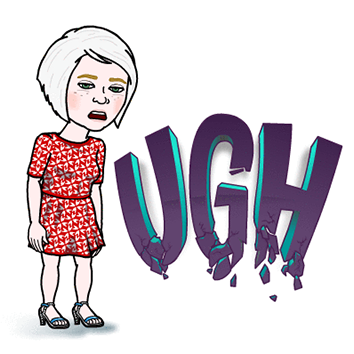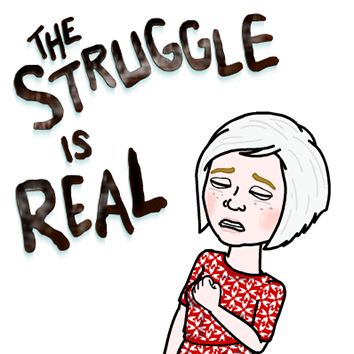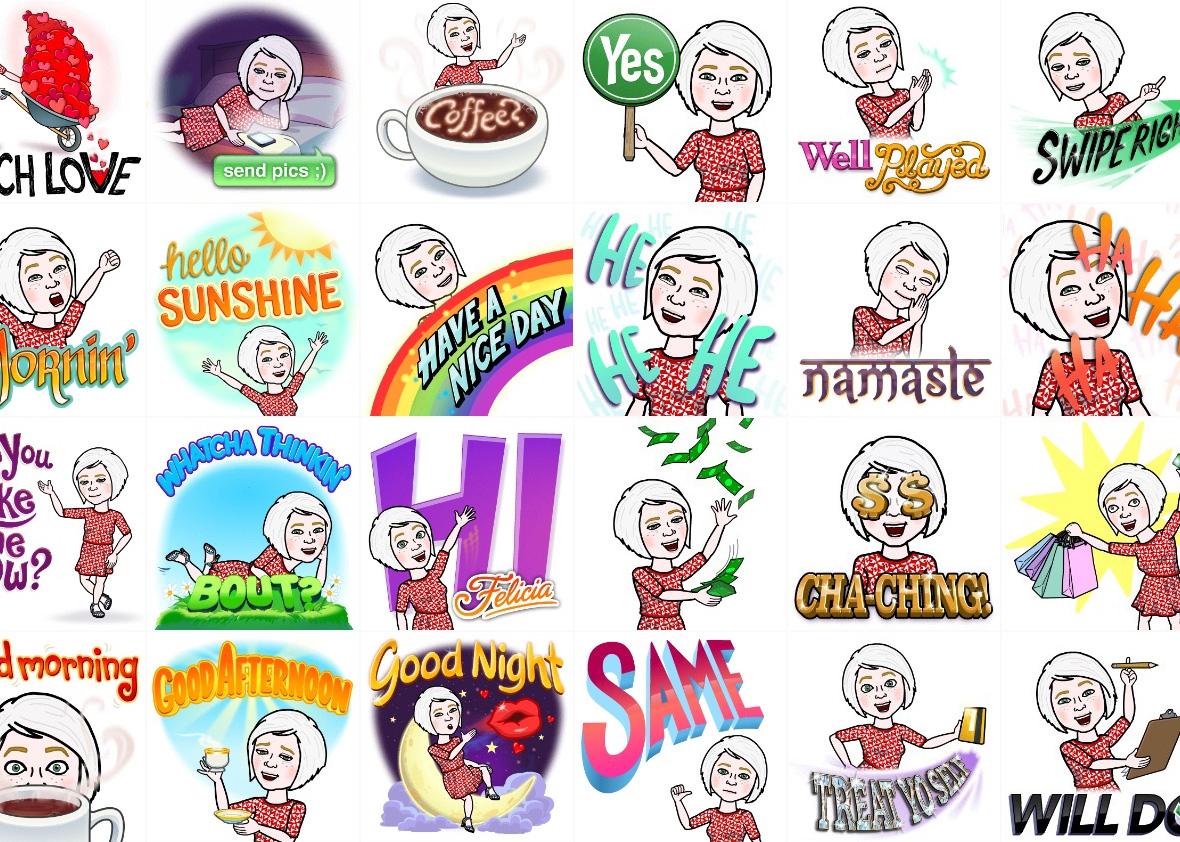I turned 30 this past year, and like many Americans who are finally ready to grow up, I created a tiny little version of myself. Ever since she came into my life, I’ve been overjoyed, and a little obsessed. She’s this little bundle of pure emotion, always laughing or crying or scrunching her face into a fastidious little frown, and every time she feels something it’s almost like I can feel it too. I dress her up in cute outfits and send pictures to all my friends. My cartoon avatar has my haircut and my freckles and my sense of style, and I can manipulate her mug into any conceivable facial expression with a couple of taps. My Bitmoji is just like me, but less emotionally withholding and with better skin. Is that weird?
The Web used to be framed as a brave new world, so unlike “real life” that you had to shed your terrestrial form and build a digital you to navigate the Information Superhighway. Avatars could look like humanoid drones (the ones you pushed around in the life-simulation game The Sims), or robotic cyberpunks (the role-players who populated the “virtual world” of Second Life), or bright little cartoon images of woodland animals or Zodiac signs (the “buddy icons” AOL users chose to represent themselves).
The rise of social networking deflated this idea of a discrete virtual identity. Facebook and Twitter and Tumblr aren’t virtual-reality experiences. They’re “platforms,” new stages for exhibiting our authentic selves. We interact on them through “profiles,” textual and visual dossiers of our personalities and interests and groups of friends. “Social media doesn’t allow people much of a presence. It’s just a collection of some information and photos and stuff,” Bitmoji founder and CEO Jacob Blackstock told me recently. But mock up a Bitmoji avatar in your image, and all of a sudden, “you exist.”

Image courtesy of Bitmoji
If Twitter encourages us to be clever and Instagram incentivizes us to look cool, Bitmoji invites us to empathize. Blackstock told me that 90 percent of Bitmoji sharing happens in private spaces—text messages, email, group chats. A pair of texting partners can mirror the exact facial expression back at one another, their lips turning up to form the same wry smile, their cheeks blushing a matching hue. And because Bitmoji’s emotional palette is so vast, a relevant reaction is always at your fingertips. It’s difficult to express unabashed excitement, genuine affection, or emotional vulnerability in the presence of another human being. Why not let cartoon you do it instead?
Blackstock, a Canadian animator who goes by a two-letter nickname, “Ba,” was a late bloomer by start-up standards. He grew up drawing naughty versions of comic strips, got a gig at an animation studio, and spent nights alone creating a psychedelic cartoon he called Griddleville. In 2008, he launched an interactive website, Bitstrips, that let artistically challenged users mock up line-drawn versions of themselves and drop them into custom comic strips. The site was a slow-burning success; it only made its mark in 2013 when it debuted as a smartphone app. From there, Blackstock realized the comic panel format was holding his avatars back from achieving their true potential.
In the fall of 2014, when Blackstock was 38, he launched Bitmoji, an app allowing users to manipulate their avatars’ facial expressions with a tap, then paste them into text messages and chat windows. At first, Bitmoji’s emotional range was confined to the expressions of the standard emoji keyboard, but soon Blackstock and his team of illustrators experimented with adding text to the images (“Hello,” “Goodbye,” “I love you”) and drawing their avatars into increasingly elaborate states: raising an eyebrow while reading the paper on the john, relaxing on a hammock with a sly grin and a boat drink, and leaning up against a locker door like a John Hughes villain and saying, “Hey, babycakes.”
Now, Bitmoji counts Chrissy Teigen, Seth Rogen, and Julianne Moore among its fans, and movie studios and media companies want in on the action. Bitmoji has created packs pegged to Game of Thrones, Inside Out, and The Force Awakens, and designed tie-ins for Time’s “Person of the Year” and People’s “Sexiest Man Alive.” (The app itself is free but some of Bitmoji’s “theme packs” do cost money.) Over the holidays, the company rolled out fresh Bitmoji for Hanukkah, Christmas, Kwanzaa, and New Years, and users celebrated by sending 50 million Bitmoji back and forth.
Bitmoji’s success is underpinned by its avatars’ physical precision. The app’s array of eye colors, builds, bust sizes, nose shapes, wrinkles, hairdos, eyebrow colors, outfits, and accessories allow for thousands of unique avatars, each of which can be manipulated into hundreds of emotional states or social scenarios. For users, the number of options seems overwhelming at first, but the avatar-building process is intuitive enough—you just kind of know what kind of nose you have—that you can make a new you in a couple of minutes. But on the Bitmoji end, the creation process requires painstaking attention to detail. Blackstock describes the process of birthing a Bitmoji as “building digital puppets where all the features are interchangeable. Every mouth has a range of positions. Every eyelid has its own set of emotional responses.” Blackstock and his crew code instructions for how every possible puppet string should pull into position so that when an individual user dials up her own avatar, her particular eye-shape folds into that particular squint. Once the facial expression, body language, and typographical treatment fall into place, Blackstock says, “we can help you convey a feeling better than you could on your own.”
Dial up the Bitmoji app, and your avatar will turn up her eyebrows into a sympathetic display, gaze straight into your text partner’s eyes, and spell it out in bubbly pink text: “I MISS U.” Or she’ll kick back her heel, stare morosely at the floor, and say: “I’M SORRY.” If real you feels like flipping over a dinner table in silent rage, you can outsource your anger to your Bitmoji: It’s oddly calming, and easier to clean up. There’s something unexpectedly charming about the image of a silly cartoon bent into an incredibly precise emotional expression, even a negative one. You can’t stay mad at these faces.

Image courtesy of Bitmoji
I’m convinced that Bitmoji can help encourage emotional disclosures and accelerate bonding, and that the virtual expression of love can help encode the real thing. “My girlfriend is going to school in another city, and Bitmoji’s been a big help in doing long distance, because it really makes you feel more present in your chat,” Blackstock told me. For me, Bitmoji functions almost like fan-fiction for my own life. My Bitmoji is not quite me, and my boyfriend’s Bitmoji is not quite him, and I like to imagine that they’re dating one another.
Blackstock humors me: “It’s pretty awesome how people become invested in these characters and really begin to love them.” Get deep enough into the Bitmoji world and you might just fall for an avatar, too—your own, probably. “People form this intense bond with their avatars,” Blackstock told me. “It really becomes an extension of themselves.” And vice-versa. As virtual reality scholar Frank Biocca put it in a 1997 essay: “The more natural the interface, the more ‘human’ it is, the more it adapts to the human body and mind.” But also: “The more the interface adapts to the human body and mind, the more the body and mind adapts to the non-human interface.”
Researchers at Stanford’s Virtual Human Interaction Lab have found that people who interact through avatars online “may come to behave in ways that are consistent with the characteristics of their manipulated identities” even after they log off. The more closely Bitmoji mimics human emotions, the more we emote like a Bitmoji. Sometimes, when I get annoyed, I find myself twisting my face into a grimace and miming flipping over a table, just like my cartoon does. Turns out it’s cathartic in real life, too.
Bitmoji users’ deep identification with their avatars means they feel a kind of ownership over the landscape of the app itself. They have opinions about how their avatars should feel. Bitmoji staffers keep a running list of emotional states and social trends they’ve yet to design, but they also source concepts from users, who can tweet to #mybitmoji to beg for a pregnant Bitmoji, or a Bitmoji that feels refreshed, or a Bitmoji that says “That’s what she said.” The most popular suggestions are added to the queue to be designed for future release.
The Unicode Consortium, the somewhat opaque governing body that approves new emoji characters, moves at a glacial pace. It can take years for a glyph to move from conception to keyboard. But Bitmoji’s lean staff designs at breakneck speed, releasing at least six fresh Bitmoji every week, with each new set hitting a variety of emotional notes. But fans are always hungry for more. When the Roots frontman Questlove woke up on “Back to the Future Day,” thumbed over to Bitmoji, and found no McFly-themed skin for his Bitmoji avatar, he took to Instagram to complain, and Blackstock got the message. “We thought, ‘Oh, shit. We’ve got to put Questlove on a hoverboard right now,’ ” he says. Within a few hours, Questlove was floating. Even the slightest tweak or oversight by the Bitmoji team can perturb true bitlievers. One user knocked a star off his online review of the app because “I’m bummed they took away the bow tie options.”

Image courtesy of Bitmoji
Bitmoji giveth, and Bitmoji taketh away. Last October, an update to the app touted “tons of spectacular new outfits” designed in collaboration with fashion brands like Calvin Klein and Rodarte. But some users who selected the sparkly new threads—my Bitmoji picked out a red floral A-line skirt and matching top by Tanya Taylor—found that their avatars mysteriously shrank in size.* Fat Bitmoji were suddenly slim. The Bitmoji team had been forced to work so nimbly to hit deadlines with the fashion partners, Blackstock told me, they only had time to design outfits to fit the app’s most popular builds, which happen to fall on the svelter side. Instead of leaving the curvier, beefier, and rounder Bitmoji uncovered, the app opted to downsize the bigger Bitmoji to a smaller frame.
Bitmoji users identify so strongly with their avatars that losing a part of their identity feels like a virtual death. Users tweeted “my heart is breaking” and “I WANT MY FAT BACK!!” Many fought back in Bitmoji form, sending the company sour avatars that told them “I CAN’T EVEN” and “THAT SUCKS.” As one user put it in an online review, “You’ve created one more message that says fat people shouldn’t exist.”
Starting this week, Blackstock says, Bitmoji users who were shrunk in the update will slowly be returned to their previous sizes. “Our team’s been working like crazy to add those builds back in,” Blackstock tells me. “We feel bad that some people aren’t feeling represented, because obviously, Bitmoji is all about representing yourself.” Until then, the great Bitmoji downsizing of 2015 tinkles like a little alarm bell among all the happily chattering avatars. I’m having a hard time putting my feelings into words. Let me just leave this here:

Image courtesy of Bitmoji
Correction, Jan. 6, 2016: This article originally misstated that the author’s Bitmoji wore a red skirt and matching top by Trina Turk. The clothing was designed by Tanya Taylor. (Return.)
